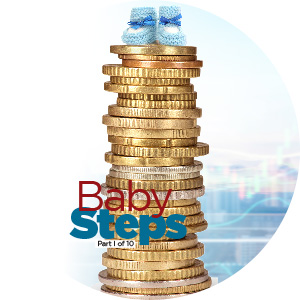Baby Steps: Chapter 1
| April 27, 2021I didn’t need to be a health expert to know that it wasn’t normal to be married for over two years with no luck in the baby department
December 2015
You don’t know what will happen in the end. Whatever happens, though, make sure that you keep your marriage strong,” said the voice on the other line.
Strong. The word echoed dimly in my mind, as if I were hearing it through water. I was hunched over in the passenger’s seat of my car, too numb to move. How could I be strong when I could barely feel my body?
“You there?” asked Naomi, my dear friend and mentor.
“Yeah,” I mumbled, “but I gotta go… I need to…” my voice trailed off weakly as I tried not to cry into the phone.
“Okay. I’m here for you. The marriage is what’s important, remember that. We’ll talk soon.”
I hung up, then dragged myself out of the car and through the front door of our condo. I slumped onto the couch, curling up as the morning’s appointment replayed in my head — the tests that confirmed that I couldn’t have children naturally, followed by a brief meeting with the fertility specialist in his office. The feeling of hope draining as we heard the doctor say that we were free to try any treatment we wanted, but that we would probably end up needing invasive procedures to have a child — and even then, our odds weren’t great.
Finally, we were ushered into a meeting with nurses to discuss options for a variety of medical interventions. The nurses had barely glanced in our direction while handing us a folder with treatment and financing information, while my brain struggled to process that I was probably never going to have a baby on my own.
Now home, I took the folder out of my purse and flipped through it blindly, my eyes unfocused as they scanned through information about tests, medications, and procedure costs. My husband, Nat, walked over to take a look at the papers.
“You okay?” he asked gently.
“Nope.” It was the truth.
“Surprised by anything the doctor said? There was a lot of ‘medical-speak’ at that appointment.”
“Also nope.” It was also the truth. I’d been well-versed in “medical-speak” for years. I had a degree in biology and was earning a master’s degree in science education. But I didn’t need to be a health expert to know that it wasn’t normal to be married for over two years with no luck in the baby department.
“What are those?” Nat asked, indicating the papers in the folder.
“Payment info for treatment,” I said. “You know, so you can pay for your baby with a down payment and low monthly fee.” I gave a half-smile.
Nat grinned. “What do they do if you can’t pay? Repossess the kid?”
“Sell ’em off at auction,” I answered. Sarcasm was a nice distraction, if only for a moment.
“Seriously, though,” I said as my smile dropped, “I can’t imagine taking out a loan for fertility treatments. What if they don’t work? Then you’re stuck paying for failed attempts… with interest.”
“That would be awful,” Nat agreed.
“If we do this,” I went on, “I want to save up and just pay the clinic up front. Even if that means we have to put off treatment for a little while. I just want the payment to be over and done.”
“That makes sense. Do you want to see how long it’ll take to save up for IVF? It’s the most expensive treatment, right?” Nat asked. I nodded, and he hopped off the couch, returning with a pencil.
I found the page in the folder labeled “Cost of Treatment” and circled the total: $25,000, including medication and monitoring costs. In the margin of the page, I jotted down our monthly income, including Nat’s paycheck from his full-time IT job and the stipend from my teaching fellowship. Then, I started listing our monthly expenses — I’d never been a formal “budgeter,” but I was pretty sure I knew where our money was going every month.
“Mortgage, HOA fee, food…” I wrote each one on the page, next to the amount we spent.
“Also, remember the car payment,” Nat added, “and the furniture payment. Those come out to $300 a month, total.”
“Right,” I said as I wrote those numbers down. I glanced at our coffee table, along with a few other furniture pieces, that we’d bought with a store credit card when we moved into our condo. The monthly payment had been so low that I’d forgotten about it altogether.
“And don’t forget our student loans,” Nat added.
“Oh, man. Those.” I’d gone to college on a tuition scholarship but had taken out some loans to cover my room and board. Nat’s master’s degree from Columbia had been completely financed, since we figured we’d pay it off eventually.
“How much are we paying on those?” I asked.
“The minimum,” Nat replied, after looking it up on his banking app. “It’s $780 a month, between the two loans.”
I blinked. $780 a month? Was it really that much? Our student loans, plus the car and credit card payments, were eating up $1,080 of our income every month — nearly half of our take-home pay.
“Hold on. How much do we owe, in total?” I asked, afraid of the answer.
Nat took a few minutes to look up the information and add up the figures. “Between our student loans, the car, and the credit card, we owe $91,000. Then, with the mortgage…”
Nat finished his sentence, but I had gone numb again and couldn’t hear him. $91,000. Nearly six figures in debt — there was no way we were going to be able to save up $25,000 any time soon. Not to mention, of course, the costs of any treatments we wanted to try before moving to IVF.
Keep the marriage strong, Naomi’s voice reminded me in my head. “Let’s talk about this later,” I suggested, getting up from the couch. “I’m tired, and I’ve got lesson planning to do before school starts up again next week.”
I willed myself to stop thinking about treatments for the remainder of winter break. Maybe Hashem will make a miracle, I thought. Maybe all this worry will be for nothing….
to be continued…
(Originally featured in Mishpacha, Issue 858)
Oops! We could not locate your form.


